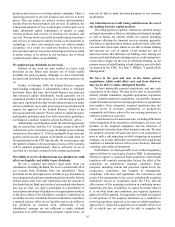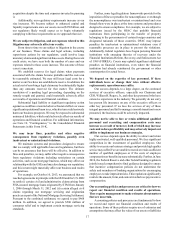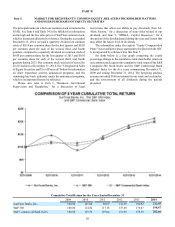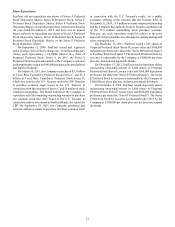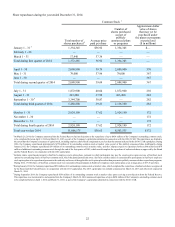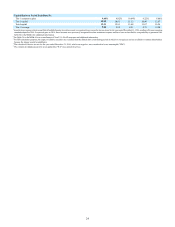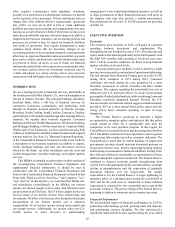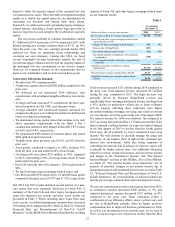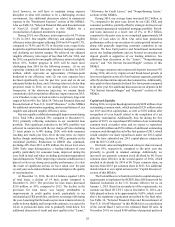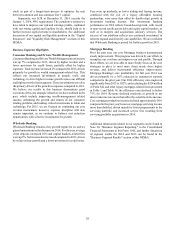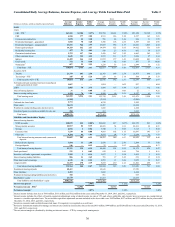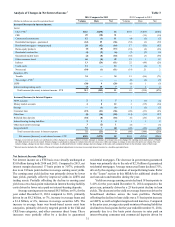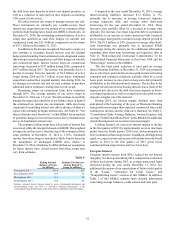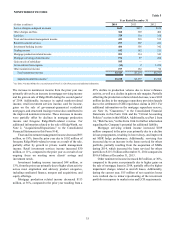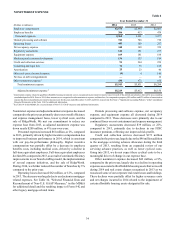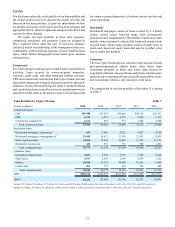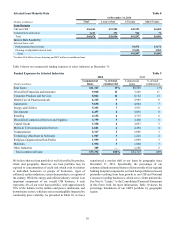SunTrust 2014 Annual Report Download - page 49
Download and view the complete annual report
Please find page 49 of the 2014 SunTrust annual report below. You can navigate through the pages in the report by either clicking on the pages listed below, or by using the keyword search tool below to find specific information within the annual report.26
other negative consequences from regulatory violations,
possibly even inadvertent or unintentional violations; we depend
on the expertise of key personnel. If these individuals leave or
change their roles without effective replacements, operations
may suffer; we may not be able to hire or retain additional
qualified personnel and recruiting and compensation costs may
increase as a result of turnover, both of which may increase costs
and reduce profitability and may adversely impact our ability to
implement our business strategies; our accounting policies and
processes are critical to how we report our financial condition
and results of operations. They require management to make
estimates about matters that are uncertain; changes in our
accounting policies or in accounting standards could materially
affect how we report our financial results and condition; our stock
price can be volatile; our disclosure controls and procedures may
not prevent or detect all errors or acts of fraud; our financial
instruments carried at fair value expose us to certain market risks;
our revenues derived from our investment securities may be
volatile and subject to a variety of risks; and we may enter into
transactions with off-balance sheet affiliates or our subsidiaries.
INTRODUCTION
We are a leading provider of financial services, particularly in
the Southeastern and Mid-Atlantic U.S., and our headquarters is
located in Atlanta, Georgia. Our principal banking subsidiary,
SunTrust Bank, offers a full line of financial services for
consumers, businesses, corporations, and institutions, both
through its branches (located primarily in Florida, Georgia,
Maryland, North Carolina, South Carolina, Tennessee, Virginia,
and the District of Columbia) and through other national delivery
channels. We operate three business segments: Consumer
Banking and Private Wealth Management, Wholesale Banking,
and Mortgage Banking, with the remainder in Corporate Other.
Within each of our businesses, we have growth strategies both
within our Southeastern and Mid-Atlantic footprint and targeted
national markets. See Note 20, "Business Segment Reporting,"
to the Consolidated Financial Statements in this Form 10-K for
a description of our business segments. In addition to deposit,
credit, mortgage banking, and trust and investment services
offered by the Bank, our other subsidiaries provide asset and
wealth management, securities brokerage, and capital markets
services.
This MD&A is intended to assist readers in their analysis of
the accompanying Consolidated Financial Statements and
supplemental financial information. It should be read in
conjunction with the Consolidated Financial Statements and
Notes to the Consolidated Financial Statements in Item 8 of this
Form 10-K. When we refer to “SunTrust,” “the Company,” “we,”
“our,” and “us” in this narrative, we mean SunTrust Banks, Inc.
and subsidiaries (consolidated). In the MD&A, net interest
income, net interest margin, total revenue, and efficiency ratios
are presented on an FTE basis. The FTE basis adjusts for the tax-
favored status of net interest income from certain loans and
investments. We believe this measure to be the preferred industry
measurement of net interest income and it enhances
comparability of net interest income arising from taxable and
tax-exempt sources. Additionally, we present other non-U.S.
GAAP metrics to assist investors in understanding
management’s view of particular financial measures, as well as
to align presentation of these financial measures with peers in
the industry who may also provide a similar presentation.
Reconcilements for all non-U.S. GAAP measures are provided
in Table 34.
EXECUTIVE OVERVIEW
Economic
The economy grew modestly in 2014, with gains in consumer
spending, business investment, and employment. The
unemployment rate finished the year at 5.6%. Fixed income and
equity markets fluctuated significantly in the fourth quarter, with
the S&P 500 volatility index peaking at levels not seen since
2012. Current economic conditions are likely to keep financial
market volatility at elevated levels.
Corporate profits grew modestly in 2014, aided by a slight
increase in revenue and a continuation of operational rightsizing.
The real national Gross Domestic Product grew at a rate of 2.4%
during 2014, compared to 2.2% during 2013. Consumer
confidence increased during the year, propelled by a more
favorable assessment of current economic and labor market
conditions. The concern regarding the persistently low rate of
inflation in the U.S. increased when U.S. crude oil and natural
gas supplies flooded global markets, while weakening Asian and
European economies dampened demand. Overall, the U.S.
macroeconomic environment outlook suggests continued steady
growth in 2015 as a more neutral fiscal policy stance and low
energy prices boost consumer spending, in spite of wage
stagnation.
The Federal Reserve continued to maintain a highly
accommodative monetary policy and indicated that this policy
would remain in effect for a considerable time after the
completion of its asset purchase program. In this regard, the
Federal Reserve concluded its asset purchase program in October
2014. The further reduction of its asset purchases was in response
to improving labor market and other economic indicators. The
Federal Reserve noted that its sizable holdings of longer-term
government securities should maintain downward pressure on
longer-term interest rates, thereby supporting housing markets
and fostering accommodative financial conditions. During 2014,
the yield curve flattened considerably as expectations for future
inflation and global expansion moderated. The Federal Reserve
continues to forecast economic growth strengthening from
current levels with appropriate policy accommodation, a gradual
decline in unemployment, and the expectation of gradually
increasing inflation over the longer-term. The market
expectation is for the Federal Reserve to begin tightening its
monetary policy at a measured pace during the second half of
2015 and for the yield curve to remain flat as future inflation
expectation is contained by low commodity prices and global
economic weakness. The precise timing of the Federal Reserve
beginning to tighten its monetary policy remains uncertain.
Financial Performance
We demonstrated improved financial performance in 2014 by
generating solid earnings growth, growing loans and deposits,
and maintaining expense discipline. We also experienced a
significant improvement in asset quality during the year, which


